Related Research Articles
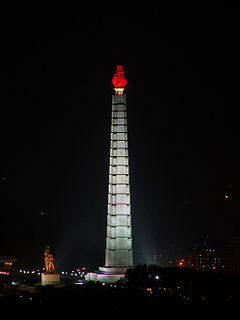
The Juche Tower, completed in 1982, is a monument in Pyongyang, the capital of North Korea, and is named after the ideology of Juche introduced by the country's first leader, Kim Il-sung.
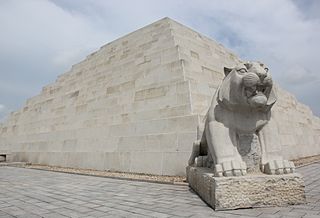
The Mausoleum of Tangun is an ancient burial site in Kangdong near Pyongyang, North Korea. It is claimed by North Korea to be the tomb of Tangun, legendary founder of Gojoseon, the first Korean kingdom.

The Taedong River is a large river in North Korea. The river rises in the Rangrim Mountains of the country's north where it then flows southwest into Korea Bay at Namp'o. In between, it runs through the country's capital, Pyongyang. Along the river are landmarks such as the Juche Tower and Kim Il-sung Square.
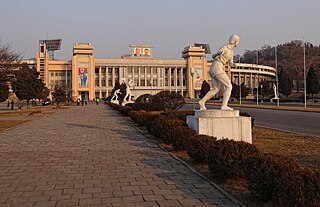
Kim Il-sung Stadium is a multi-purpose stadium located in Pyongyang, the capital city of North Korea. The stadium is used primarily for association football matches.

The Arch of Triumph is a triumphal arch in Pyongyang, North Korea. It was built to commemorate the Korean resistance to Japan from 1925 to 1945. It is the second tallest triumphal arch in the world, after Monumento a la Revolución in Mexico, standing 60 m (197 ft) high and 50 m (164 ft) wide.

Moranbong-guyŏk (Korean: 모란봉구역), or the Moranbong District, is one of the 18 guyŏk which constitute the capital city of Pyongyang, North Korea. It is located north of Chung-guyok, the city's central district, and is bordered to the north by Sosong and Taesong-guyoks, to the east by the Taedong River, and the west by the Potong River and Potonggang-guyok. It is named after Moran Hill located in the district's west area. It was designated a guyŏk in October 1960 by the Pyongyang City People's Committee.
Rangrang-guyŏk or Rangrang District is one of the 18 kuyŏk that constitute the city of Pyongyang, North Korea. It is located south of the Taedong River, and is bordered to the north by Songyo-guyok, to the east by the Ryokpo-guyok, and to the south by Chunghwa and Kangnam counties.
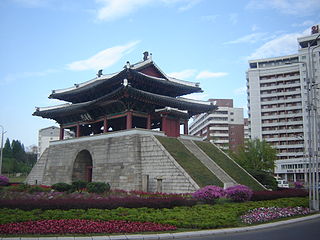
Potong Gate is the western gate of the inner complex of the walled city of Pyongyang. It was originally built in the sixth century as an official Koguryo construction, and was later rebuilt in 1473. It features a granite base topped by a two-story pavilion. The gate's pavilion was destroyed by American bombings during the destruction of Pyongyang in Korean War, but was later reconstructed in 1955.

Taedong Gate is the eastern gate of the inner castle of the walled city of Pyongyang, and one of the National Treasures of North Korea. Located on the banks of the Taedong River, from which it gets its name, the gate was originally built in the sixth century as an official Koguryo construction, and, along with the Ryongwang Pavilion and Pyongyang Bell, served as the center of the inner castle's eastern defenses. The present construction dates from 1635, however, as the original was burnt to the ground during the Imjin wars of the late 16th century.

Pyongyang Marathon, also known as Mangyongdae Prize International Marathon, is an annual marathon race contested each April in Pyongyang, the capital of North Korea. It is categorised as an IAAF Bronze Label Road Race.

The Tomb of King Tongmyŏng is a mausoleum located in near Ryongsan-ri, Ryokpo-guyok, Pyongyang, North Korea. One of the tombs is the royal tomb of Dongmyeong, the founder of the ancient Goguryeo kingdom, northernmost of the Three Kingdoms of Korea. In total, there are 63 individual tombs of the period. The area around the Tongmyong contains at least fifteen known tombs believed to belong to various vassal lords. The tomb has achieved World Heritage status as part of the Complex of Koguryo Tombs inscribed by UNESCO in 2004 under Criteria (i), (ii), (iii) and (iv) covering an area of 233 hectares with a buffer zone of 1,701 hectares. A unique feature of this and the other extant tombs in the area are its wall paintings depicting lotuses blossoming of that period indicative of Buddhism practiced in Korea.
Room 39 is a secretive North Korean party organization that seeks ways to maintain the foreign currency slush fund for the country's leaders.
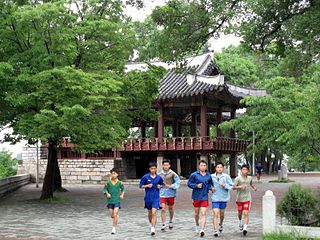
Ryongwang Pavilion is a scenic overlook located in the central district of Pyongyang, North Korea. Located on the bank of the Taedong River, the pavilion was first constructed during the Goguryeo dynasty as "Sansu Pavilion", and was part of the defenses of the walled city of Pyongyang. It is labeled as National Treasure #16 in North Korea.
Ch'ilsŏng Gate is the northern gate of the inner castle of the walled city of Pyongyang. Located in the scenic Moranbong Park, the gate was originally built in the sixth century as an official Koguryo construction, although present construction dates from 1712. The gate takes its name from the seven brightest stars in the Great Bear constellation. This constellation was revered in traditional Korean religion - for example, many Buddhist temples in Korea contain a "Chilsong shrine" or other similar structure.

Pyongyang station is the central railway station of P'yŏngyang, North Korea. It is located in Yŏkchŏn-dong, Chung-guyŏk.

Yŏngmyŏng Temple was a Korean Buddhist temple located at the foot of Moranbong hill in Pyongyang, North Korea. Prior to its destruction in the Korean War, it was the largest and most important center of Buddhist worship in that city. Though it is unknown when the temple was founded, popular tales date it to the end of the Goguryeo kingdom. The temple was completely rebuilt under the Joseon dynasty. Under the Japanese occupation of Korea, the temple became a major tourist site in Pyongyang it was renowned for its beautiful riverside location and many cherry trees. In the 1920s it again underwent an extensive restoration funded by the Japanese government, who also officially changed its name to its Japanese pronunciation, "Eimei-ji". During that time, the temple was also confiscated from by the government, and given for use as a headquarters for the Rinzai sect of Japanese Zen Buddhism. The Rinzai monks were tasked with converting the citizens away from traditional Korean Buddhism as part of a government program to replace the old Korean culture with that of modern Japan.
Mirim Airport, also known as Pyongyang East Airfield or K-24 Air Base, is an airport in Mirim-dong, Sadong-guyok, Pyongyang-si, North Korea.
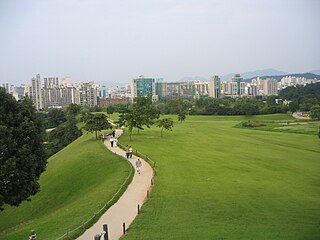
Mongchontoseong Earthen Fortification is an ancient earthen rampart dating from the Baekje kingdom. It appears to have played the same role in defending the region the fortifications constructed on Mt. Acha. The fortification walls are estimated to have been about 2.7 kilometres in length and approximately 6 to 7 metres high. The fortifications of Mongchon Toseong had two unique features: a palisade atop the wall and a moat surrounding its base. They are part of Wiryeseong with Pungnaptoseong. It is located what is now in the Olympic Park of Seoul, South Korea. During the 1988 Summer Olympics, the running portion of the modern pentathlon event were hosted there. A number of important excavations of the site were conducted prior to the construction of the nearby Olympic Park.

The Korean Central History Museum is a museum located in Pyongyang, North Korea. The museum is located at the north end of Kim Il-sung Square. It contains displays on Korean history from primitive society to the modern age.
The Anhak Palace was the royal residence of the Goguryeo kingdom after the capital was moved to Pyongyang from Gungnae. Originally built in 427 AD, the palace is located in the Taesong district of Pyongyang, North Korea, at the foot of Mount Taesong.
References
- ↑ Baek, Jong-oh (June 2006). "북한학계의 고조선 성곽 연구 동향" [Research Trend of North Korean Academy on Fortresses of Gojosun Kingdom]. 고조선단군학 (단군학연구) (in Korean). DBPia. 14: 333–360. Retrieved January 2, 2015.
- ↑ "Chongam-dong Earthen Wall". Naenara. December 9, 2015. Retrieved March 22, 2016.
- ↑ "Weaponry and Metalwork in Period of Three Kingdoms". KCNA. Pyongyang. October 19, 2007. Archived from the original on October 12, 2014. Retrieved January 2, 2015.
Coordinates: 39°2′21.19″N125°45′45.09″E / 39.0392194°N 125.7625250°E